U.S. Department of Transportation
Federal Highway Administration
1200 New Jersey Avenue, SE
Washington, DC 20590
202-366-4000
Signalized intersection-specific safety treatments assist drivers in recognizing they are at or approaching signal-controlled intersecting routes, provide storage for turning traffic,21 and give positive guidance to motorists through the intersection.
| Safety Treatment | For more information, visit page | Cost | Frequency of Maintenance (years) |
Safety Benefit | Benefit Cost Ratio22 | |||
|---|---|---|---|---|---|---|---|---|
| Initial Implementation | Ongoing Maintenance | NCHRP 500 Performance Rating |
Crash Modification Factor (CMF) | Lower Volume*, Optimal Width*** |
Higher Volume**, Optimal Conditions*** |
|||
| Improve Traffic Signal Visibility (Larger Diameter Lens or Install Back Plate) |
24 | $ | P | 0.85 | ||||
| Provide Intersection Lighting | 25 | $$ | $ | 1 | P | 0.41-0.88 | 26.9 | 93.8 |
| Install Pedestrian Signal Heads to Existing Signalized Intersections |
26 | $$ | P | |||||
| Provide Flashing Beacons at Intersection Approaches | 27 | $$$ | $ | 2 | P | 11.0 | 38.2 | |
| Use Raised Median to Restrict Turning Movements | 28 | $$$-$$$$ | P | 0.61-1.09 | ||||
| Install Priority Control Systems for Emergency Vehicles | 29 | $$$-$$$$ | T | |||||
| Provide Advanced Dilemma Zone Detection for Rural High Speed Signalized Approaches |
30 | $$$-$$$$ | P | 0.61 | ||||
| Implement J-Turns Along a Signalized Corridor | 31 | $$$$ | $ | 10 | P | 45.4 | 159.1 | |
| Install Acceleration or Deceleration Lanes | 32 | $$$$ | P | |||||
| Install Right Turn Lane | 33 | $$$$$ | $$ | 10 | P | 0.77-0.96 | 4.9 | 159.1 |
| Install Left Turn Lane | 34 | $$$$$ | $$ | 10 | P | 0.50-0.80 | 4.1 | 14.1 |
| Install Offset (or Channelized) Left Turn Lane | 35 | $$$$$ | $$ | 10 | P | 0.80 | 4.1 | 14.1 |
| Convert a Traditional Signalized Intersection into a Roundabout |
36 | $$$$$ | $$$ | 10 | P | 0.26-0.82 | 4.8 | 16.6 |
| Reconstruct At-Grade Intersection to Create an Interchange | 37 | $$$$$ | $$$ | 10 | P | 0.43-0.64 | 0.1 | 0.4 |
Cost: NCHRP 500 Performance rating23 *Lower Volume ≤1000 vpd |
||||||||
Enhancing the visibility of traffic signals can help to eliminate red-light running and associated crashes. Enhancements may include installing signal lenses with a larger diameter and using reflective back plates.
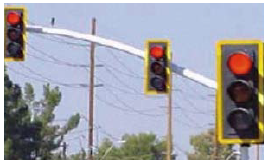
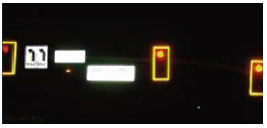
Where to Use: This treatment may be used when crash types such as red-light running indicate that visibility of traffic signal is an issue.
| Safety Treatment | Initial Implementation Cost |
NCHRP 500 Performance Rating |
Crash Modification Factor (CMF) |
|---|---|---|---|
| Improve Traffic Signal Visibility | $2,000 | Proven | 0.85 |
Top Recommended Resource:
1. FHWA, Signalized Intersections Informational Guide, July 2013. Available at: http://safety.fhwa.dot.gov/intersection/conventional/signalized/fhwasa13027/.
Many intersection crashes during late-night and early-morning hours occur due to poor visibility, which results in drivers being unable to see conflicting traffic, other road users, or–specifically in the case of unsignalized intersections–the presence of the intersection itself. At night in rural areas, the only source of lighting for roadways is often provided by vehicle headlights. Roadway lighting allows for greater visibility of the intersection, which makes the intersection more conspicuous to motorists and provides aid in helping drivers determine their paths through the intersection by making signs and markings more visible.
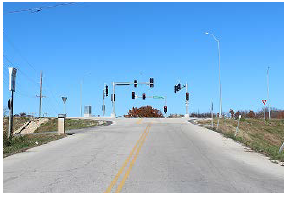
Where to Use: Lighting should be provided at signalized or unsignalized intersections, particularly those with a high instance of dark crashes. Rear-end, right-angle, or turning crashes on the major road approaches to an unsignalized intersection may indicate that approaching drivers are unaware of the presence of the intersection.
| Provide Intersection Lighting - Initial Investment: $20,000 - Cost of Maintenance: $500 - Frequency of Maintenance: 1 year |
Benefit-Cost Ratio | NCHRP 500 Performance Rating | Crash Modification Factor (CMF) |
|---|---|---|---|
| Lower Volume Signalized Intersections | 26.9 | Proven | 0.41–0.88 |
| Higher Volume Signalized Intersections | 93.8 | Proven | 0.41–0.88 |
Top Recommended Resource:
1. FHWA, Signalized Intersections Informational Guide, July 2013. Available at: http://safety.fhwa.dot.gov/intersection/conventional/signalized/fhwasa13027/.
Pedestrian signal heads provide special types of traffic signal indications exclusively intended for controlling pedestrian traffic. These signal indications consist of the illuminated symbols of a walking person (symbolizing Walk) and an upraised hand (symbolizing Don't Walk).
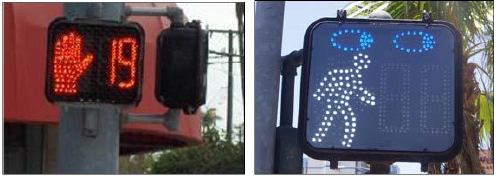
Where to Use: This treatment is applicable where pedestrian traffic exists at signalized intersections.
| Safety Treatment | Initial Implementation Cost | NCHRP 500 Performance Rating |
|---|---|---|
| Install Pedestrian Signal Heads to Existing Signalized Intersections | $5,001 to $20,000 | Proven |
Top Recommended Resources:
1. FHWA, Manual on Uniform Traffic Control Devices, "Chapter 4E. Pedestrian Control Features," December 2009. Available at: http://mutcd.fhwa.dot.gov/pdfs/2009r1r2/mutcd2009r1r2edition.pdf.
2. FHWA, Signalized Intersections Informational Guide, July 2013. Available at: http://safety.fhwa.dot.gov/intersection/conventional/signalized/fhwasa13027/.
Flashing beacons provide a visible signal to the presence of an intersection and can be very effective in rural areas where there may be long stretches between intersections as well as in locations where nighttime intersection visibility is an issue.
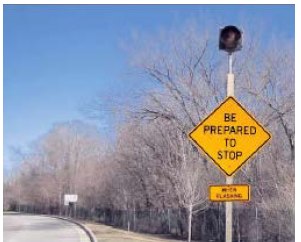
Where to Use: Flashing beacons can be installed prior to signalized intersections with patterns of right-angle crashes related to lack of driver awareness of the upcoming signalized intersection. The beacons can be installed atop Advance Signal Ahead signs.
| Provide Flashing Beacons at Intersection Approaches – Initial Investment: $25,000 – Cost of Maintenance: $1,000 – Frequency of Maintenance: 2 years |
Benefit-Cost Ratio | NCHRP 500 Performance Rating |
|---|---|---|
| Lower Volume Signalized Intersections | 11.0 | Proven |
| Higher Volume Signalized Intersections | 38.2 | Proven |
Top Recommended Resource:
1. FHWA, Signalized Intersections Informational Guide, July 2013. Available at: http://safety.fhwa.dot.gov/intersection/conventional/signalized/fhwasa13027/.
Raised medians can be helpful in limiting access and restricting turning movements within the functional limits of intersections, thereby reducing conflicts between through traffic and turning vehicles.
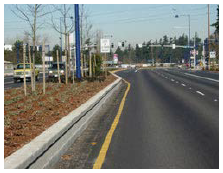
Where to Use: This treatment may be used at locations where access to streets, businesses, homes, and other properties falls within the intersection functional area.
| Safety Treatment | Initial Implementation Cost | NCHRP 500 Performance Rating | Crash Modification Factor (CMF) |
|---|---|---|---|
| Use Raised Median to Restrict Turning Movements | $20,001 to $100,000 |
Proven | 0.61–1.09 |
Top Recommended Resource:
1. FHWA, Signalized Intersections Informational Guide, July 2013. Available at: http://safety.fhwa.dot.gov/intersection/conventional/signalized/fhwasa13027/.
Emergency priority control systems are designed to give emergency response vehicles a green indication on their approach to a signalized intersection while providing a red light to conflicting approaches.
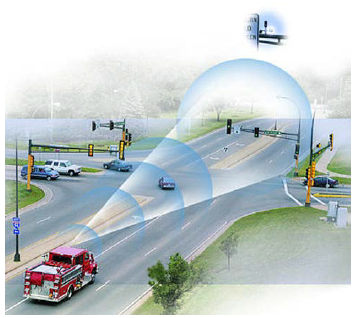
Where to Use: This system may be most beneficial where vehicles approaching a green signal cannot see emergency vehicles approaching on the intersecting roadway because of line-of-sight problems with nearby buildings, vegetation, or hills.
| Safety Treatment | Initial Implementation Cost | NCHRP 500 Performance Rating |
|---|---|---|
| Install Priority Control Systems for Emergency Vehicles | $20,001 to $100,000 | Tried |
Top Recommended Resources:
1. FHWA, Traffic Signal Preemption for Emergency Vehicles: A Cross-Cutting Study, January 2006. Available at: http://www.gtt.com/wp-content/uploads/Traffic-signal-preemption-for-emergency-vehicles-A-cross-cutting-study.pdf.
2. FHWA, Traffic Signal Timing Manual, "Chapter 9," June 2008. Available at: http://ops.fhwa.dot.gov/publications/fhwahop08024/chapter9.htm
Advanced dilemma zone detection systems enhance safety at signalized intersections by modifying traffic control signal timing to reduce the number of drivers that may have difficulty deciding whether to stop or proceed during a yellow phase. This may reduce rear-end crashes associated with unsafe stopping and angle crashes due to illegally continuing into the intersection during the red phase.
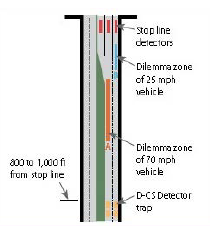 |
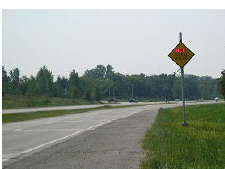 Note: The sign shown may not be consistent with the latest version of the MUTCD. |
Where to Use: This treatment may be used at locations with a high frequency of crashes associated with the traffic signal phase change (e.g., rear-end and angle crashes) and high frequencies of red-light violations. Additional benefits of this treatment include reducing delay and stop frequency on the major road and maintaining or reducing overall intersection delay.
| Safety Treatment | Initial Implementation Cost | NCHRP 500 Performance Rating | Crash Modification Factor (CMF) |
|---|---|---|---|
| Provide Advanced Dilemma Zone Detection for Rural High Speed Signalized Approaches |
$20,001 to $100,000 | Proven | 0.61 |
Top Recommended Resource:
1. FHWA, Advanced Dilemma-Zone Detection System, May 2009. Available at: http://safety.fhwa.dot.gov/intersection/resources/techsum/fhwasa09008/.
The J-turn intersection is characterized by the prohibition of left turn and through movements from side street approaches as permitted in conventional designs. The J-turn intersection accommodates these movements by requiring drivers to turn right onto the main road and then make a U-turn maneuver at a one-way median opening 400 to 1,000 feet after the intersection. Left turns from the main road approaches are executed in a manner similar to left turns at conventional intersections and are unchanged in this design. Left turn movements from the major road could also be removed at primarily rural unsignalized J-turn designs.
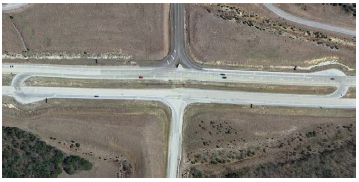
Where to Use: J-turn intersections are typically implemented as part of a corridor treatment; however, they can be used at isolated intersections. Unsignalized J-turn intersections preserve corridor capacity and can be installed without the adverse effects of signal control. Scenarios where J-turn intersections are most applicable include the following:
For intersections with very high left turn and through volumes from the side road approaches, the J-turn intersection design is not the optimal choice.
| Implement J-Turns Along a Signalized Corridor - Initial Investment: $100,000 - Cost of Maintenance: $5,000 - Frequency of Maintenance: 10 years |
Benefit-Cost Ratio | NCHRP 500 Performance Rating |
|---|---|---|
| Lower Volume Signalized Intersections | 45.4 | Proven |
| Higher Volume Signalized Intersections | 159.1 | Proven |
Top Recommended Resource:
1. FHWA, Restricted Crossing U-Turn Intersection, October 2009. Available at: https://www.fhwa.dot.gov/publications/research/safety/09059/09059.pdf.
Drivers turning onto an uncongested highway generally accelerate until they approach the desired open-road speed. When acceleration by entering traffic takes place directly on the traveled way, it may disrupt the flow of through traffic. To minimize this operational problem due to right- or left turning traffic at highway intersections, acceleration lanes may be used.
An acceleration lane is an auxiliary or speed-change lane that allows vehicles to accelerate to highway speeds before entering the through traffic lanes of a highway. Acceleration lanes should be of sufficient length to permit adjustments in speeds of both through and entering vehicles so that the driver of the entering vehicle can accelerate and maneuver into that gap before reaching the end of the acceleration lane. Additionally, the purpose of a parallel deceleration lane is to provide drivers exiting or turning from the road with an opportunity to slow down to a more reasonable speed prior to turning.
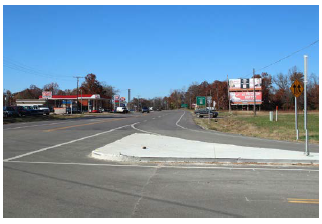
Where to Use: This treatment may be used at unsignalized intersections on highways that experience a high proportion of rear-end crashes related to the speed differential caused by vehicles turning left or right onto or from the highway. They may also be used where intersection sight distance is inadequate or where there are high volumes of trucks or recreational vehicles entering or exiting the highway.
Acceleration or deceleration lanes can be added as median acceleration/deceleration lanes, as installed at several locations in Missouri, or as lanes next to the shoulder for vehicles entering or exiting the roadway on the right side, as installed in Kentucky.
| Safety Treatment | Initial Implementation Cost | NCHRP 500 Performance Rating |
|---|---|---|
| Install Acceleration or Deceleration Lanes | $100,000 | Proven |
Top Recommended Resources:
1. FHWA. NCHRP Report 500 / Volume 5: A Guide for Addressing Unsignalized Intersection Collisions, "Strategy B9. Provide Right-Turn Acceleration Lanes at Intersections," July 2003. Available at: http://safety.fhwa.dot.gov/intersection/resources/intsafestratbro/ub9.cfm.
2. FHWA. NCHRP Report 500 / Volume 5: A Guide for Addressing Unsignalized Intersection Collisions, "Strategy B5. Provide Left-Turn Acceleration Lanes at Intersections," July 2003. Available at: http://safety.fhwa.dot.gov/intersection/resources/intsafestratbro/ub5.cfm.
Providing a right turn lane at an intersection can reduce rear-end crashes by allowing vehicles to proceed through the intersection without having to stop or slow down for vehicles making a right turn. Assuming turn lanes are of adequate length, vehicles will not be stopped in the travel lanes; this allows for through traffic to continue without stopping for vehicles turning at an intersection.
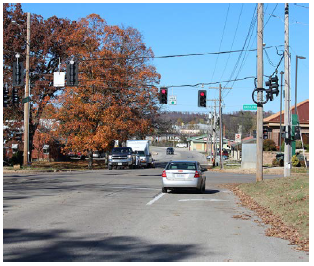
Where to Use: Right turn lanes should be constructed at intersections with a high frequency of rear-end crashes resulting from conflicts between (1) vehicles turning right and following vehicles, and (2) vehicles turning right and through vehicles coming from the left on the cross street.
| Install Right Turn Lane - Initial Investment: $400,000 - Cost of Maintenance: $20,000 - Frequency of Maintenance: 10 years |
Benefit-Cost Ratio | NCHRP 500 Performance Rating | Crash Modification Factor (CMF) |
|---|---|---|---|
| Lower Volume Signalized Intersections | 4.9 | Proven | 0.77–0.96 |
| Higher Volume Signalized Intersections | 16.9 | Proven | 0.77–0.96 |
Top Recommended Resources:
1. FHWA, Techbrief: Safety Effectiveness of Intersection Left- and Right-Turn Lanes, 2002. Available at: https://www.fhwa.dot.gov/publications/research/safety/02103/02103techbrief.pdf
2. FHWA, Signalized Intersections Informational Guide, July 2013. Available at: http://safety.fhwa.dot.gov/intersection/conventional/signalized/fhwasa13027/.
Left turn lanes are used as auxiliary lanes for storage or to accommodate left turning vehicles with decreasing speed as they approach the intersection. Installing left turn lanes can reduce rear-end crashes by allowing vehicles to proceed through the intersection without having to stop or slow down for vehicles waiting to make a left turn.
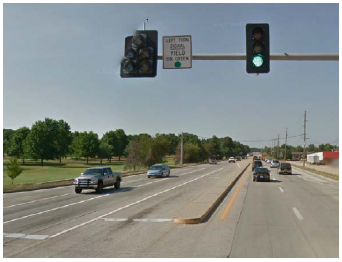
Where to Use: The AASHTO Green Book recommends that left turning traffic be removed from the through lanes whenever practical, and that left turn lanes should be provided at street intersections along major arterials and collector roads wherever left turns are permitted. Consideration of left turn lanes has traditionally been based on such factors as the number of through lanes, speeds, left turn volumes, opposing through volumes, and/or left turning crashes.
Intersections with a high frequency of crashes resulting from the conflicts between (1) vehicles turning left and following vehicles, and (2) vehicles turning left and opposing through vehicles are also candidates for the installation of left turn lanes.
Practitioners should consider installing left turn lanes for the major road approaches to improve safety at 3- and 4-leg intersections with two-way stop control on the minor road at locations where significant turning volumes exist or where there is a history of turn-related crashes.
| Install Left Turn Lane - Initial Investment: $400,000 - Cost of Maintenance: $20,000 - Frequency of Maintenance: 10 years |
Benefit-Cost Ratio | NCHRP 500 Performance Rating | Crash Modification Factor (CMF) |
|---|---|---|---|
| Lower Volume Signalized Intersections | 4.1 | Proven | 0.50–0.80 |
| Higher Volume Signalized Intersections | 14.1 | Proven | 0.50–0.80 |
Top Recommended Resources:
1. FHWA, Signalized Intersections Informational Guide, July 2013. Available at: http://safety.fhwa.dot.gov/intersection/conventional/signalized/fhwasa13027/.
2. FHWA, Intersection Safety: A Manual for Local Rural Road Owners, January 2011. Available at: http://safety.fhwa.dot.gov/local_rural/training/fhwasa1108/fhwasa1108.pdf.
Offset left turn lanes provide the left turning motorist a line of sight to opposing through vehicles. Instead of attempting to look around opposing left turning vehicles, the motorist can clearly see oncoming traffic.
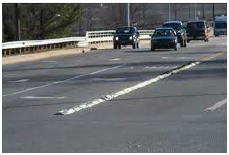
Where to Use: Offset left turn lanes should be used at unsignalized 4-leg intersections with a high frequency of crashes between vehicles turning left and opposing through vehicles. This treatment can be applied at intersections on divided highways with medians wide enough to provide the appropriate positive offset, and also on approaches without medians if sufficient width exists.
| Install Offset (or Channelized) Left Turn Lane - Initial Investment: $250,000 - Cost of Maintenance: $1,000 - Frequency of Maintenance: 10 years |
Benefit-Cost Ratio | NCHRP 500 Performance Rating | Crash Modification Factor (CMF) |
|---|---|---|---|
| Lower Volume Signalized Intersections | 4.1 | Proven | 0.80 |
| Higher Volume Signalized Intersections | 14.1 | Proven | 0.80 |
Top Recommended Resource:
1. FHWA, Signalized Intersections Informational Guide, July 2013. Available at: http://safety.fhwa.dot.gov/intersection/conventional/signalized/fhwasa13027/.
The modern roundabout is a type of circular intersection defined by the basic operational principle that entering traffic yields to vehicles on the circulatory roadway. Key design principles achieve deflection of entering traffic by channelization at the entrance and deflection around a center island. Roundabout intersections eliminate a number of vehicle conflict points typically associated with traditional intersections. A 4-leg, single-lane roundabout has 75 percent fewer vehicle conflict points than a traditional stop-controlled intersection. Roundabouts also enhance safety by reducing vehicle speeds both in and through the intersection and by changing the crash type from angle to sideswipe, which typically results in less severe crashes.

Where to Use: Roundabouts are the preferred safety alternative for a wide range of intersections. Although they may not be appropriate in all circumstances, they may be considered as an alternative for all proposed new intersections on federally-funded highway projects. Roundabouts should also be considered for all existing intersections that have been identified as needing major safety or operational improvements. This would include freeway interchange ramp terminals and rural intersections.
| Convert a Traditional Signalized Intersection into a
Roundabout - Initial Investment: $400,000 - Cost of Maintenance: $40,000 - Frequency of Maintenance: 10 years |
Benefit-Cost Ratio | NCHRP 500 Performance Rating | Crash Modification Factor (CMF) |
|---|---|---|---|
| Lower Volume Signalized Intersections | 4.8 | Proven | 0.26–0.82 |
| Higher Volume Signalized Intersections | 16.6 | Proven | 0.26–0.82 |
Top Recommended Resources:
1. FHWA, "Guidance Memorandum on Consideration and Implementation of Proven Safety Countermeasures," 2010. Available at: http://safety.fhwa.dot.gov/policy/memo071008/.
2. FHWA, Intersection Safety Case Study: Minnesota Roundabout—A Scott County Success Story, February 2010. Available at: http://safety.fhwa.dot.gov/intersection/resources/casestudies/fhwasa09013/.
In removing an existing at-grade intersection and navigating traffic through an interchange, the through movements on the major street are physically separated from the other turning movements, which are typically served by one or two intersections (ramp terminals) on the minor street. The interchange may take several forms: a diamond interchange, a single point urban interchange, and a compressed diamond interchange. Each interchange type has independent safety implications.
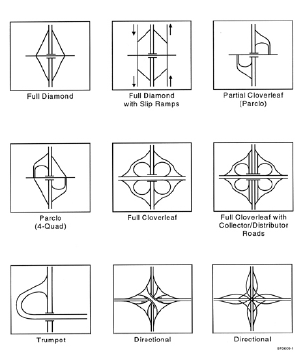
Where to Use: This improvement may be applicable to 4-leg intersections with high volumes on the through street and a high number of angle crashes.
| Reconstruct At-Grade Intersection to Create an
Interchange - Initial Investment: $10,000,00 - Cost of Maintenance: $40,000 - Frequency of Maintenance: 10 years *Calculations include a salvage value of $1,000,000 |
Benefit-Cost Ratio | NCHRP 500 Performance Rating | Crash Modification Factor (CMF) |
|---|---|---|---|
| Lower Volume Signalized Intersections | 0.1 | Proven | 0.43–0.64 |
| Higher Volume Signalized Intersections | 0.4 | Proven | 0.43–0.64 |
Top Recommended Resources:
1. FHWA, Signalized Intersections Informational Guide, July 2013. Available at: http://safety.fhwa.dot.gov/intersection/conventional/signalized/fhwasa13027/.
2. FHWA, Rural Public Transportation Technologies: User Needs and Applications FR1-798, July 1997. Available at: https://www.fhwa.dot.gov/publications/research/safety/97106/ch01/ch01.cfm.
21 Turn lane storage is the length of turn lane provided based on anticipated traffic needs. [ Return to note 21. ]
22 As discussed in Section 1.2, a BCR is only shown where data were available to calculate the ratio. Where data were unavailable, the BCR has been left blank. [ Return to note 22. ]
23 As stated in NCHRP Series 500 Reports (http://safety.transportation.org/guides.aspx). Proven: The safety effect for other similar applications has shown a proven benefit. Tried: The treatment has indications that it can be expected to reduce crashes, but has some conflicting reports as to its associated safety effects or has been deployed and observed to be effective. Experimental: New treatments that still need to be tested and for which the safety effect is unknown. Unknown: Not enough is known about an associated safety performance. [ Return to note 23. ]
